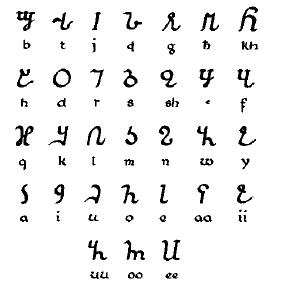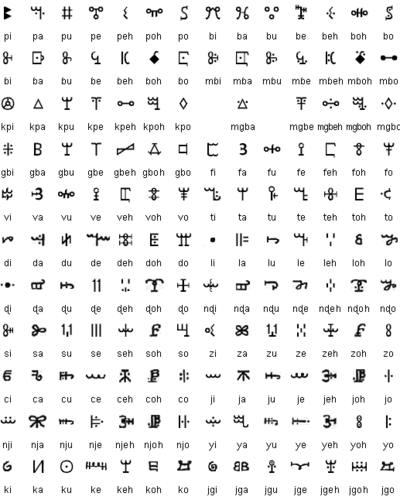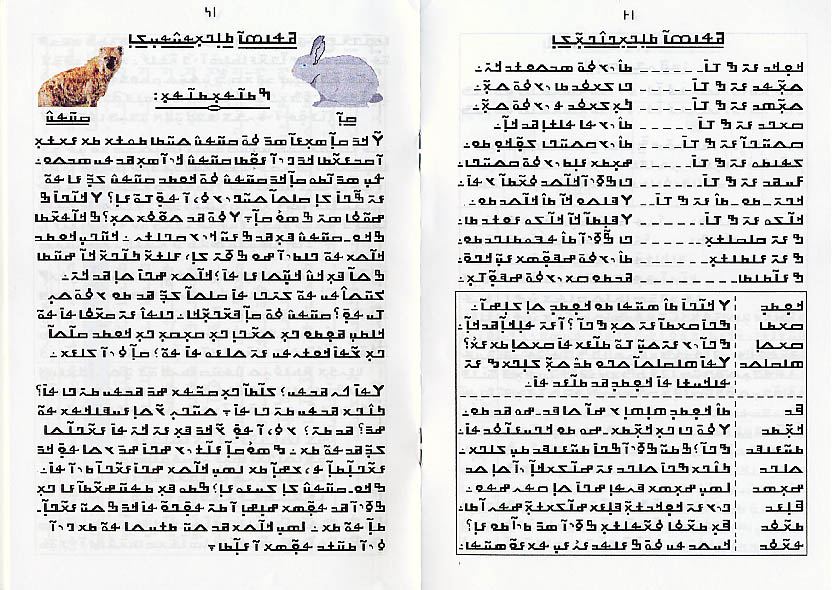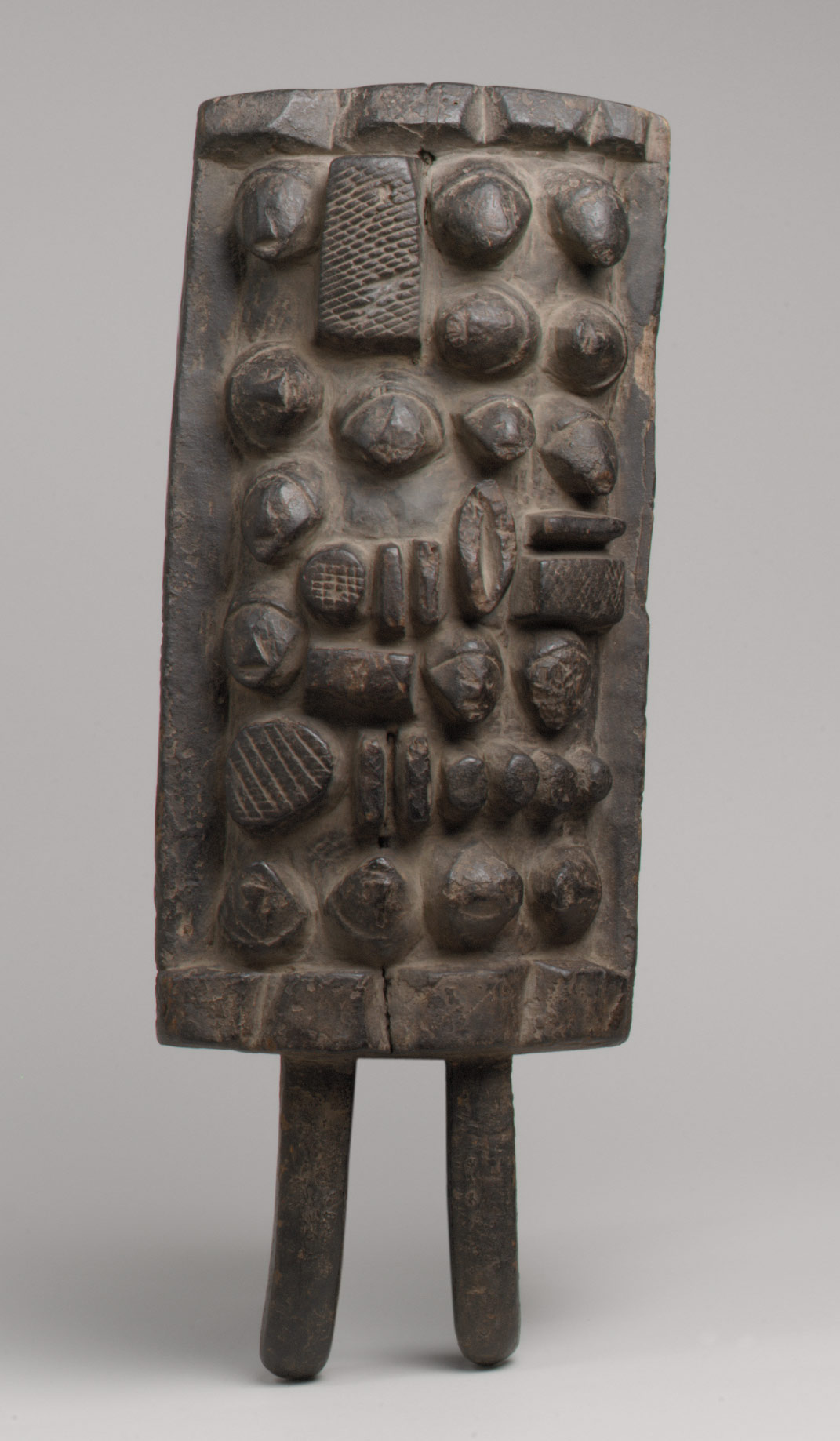African Script - Culture - Nairaland
Nairaland Forum / Nairaland / General / Culture / African Script (44201 Views)
| African Script by Nnenna1(f): 1:30am On Oct 29, 2008 |
The other day I ran across an article on the Nsibidi script, a system of written symbols that members of the Ekpe secret society of the South East region of Nigeria used to communicate hidden information with. A sample of this is shown below: [img]http://www.library.cornell.edu/africana/Writing_Systems/nsibidi.GIF[/img] The origins of these symbols date way before colonization, but, from my understanding, the use of these symbols died out as the influence of Ekpe secret society lessened. The article was a not-so-deep exploration of indigenous African writing systems and languages. It brings to mind the consensus that Africans never had a written system before the advent of Europeans. For instance, Nigerian traditional languages, when written, are done so with the Roman alphabet. Anyways, I was fascinated, looked more into the topic, and found more writing systems. Ge'ez:  This has shared origins with Arabic script, and is often refered to as Ethiopic writing. Mostly used by Ethiopians and Eritreans for Amharic, Tigrinya, Tigre languages. Oldest discovered forms date back to 9th century BC. Osmanya:  The writing script for Somalian languages. Invented early 20th century. The Vai Syllabary:  Written expressions of the Vai Language in Liberia and parts of Sierra Leone. Was coined in early 19th century. Bamun Script:  Script used among Bamun language speakers of Cameroon. Origins also date as far back as nineteenth century. It is rarely used today. KikaKui:  [img]http://upload.wikimedia.org/wikipedia/commons/8/8d/Mehnde_yia.PNG[/img]  This is the writing used for the Mende speaking people of Sierra Leone. It was actually popular at about the time it was invented - which I think was about the mid-nineteenth century. It's rarely used too  . . N'Ko:  Popularized in Gineau. Originated in 1949. Madombe:  This one was created in 1978 in the Democratic Republic of Congo. Apparently it's used for Swahili and Lingala. Sorry for the gigantic picture. One thing strikes me here: Aside from the Nsibidi script, which is not as complex a writing system as is the average script, and the Ethiopic Ge'ez, the others were created quite recently. The story behind them seems to be that their inventors created them as a retort to the myth that Africans were without culture and civilization. Not that it should matter because at the time of their creation, they did attract some devotion to indigenous identity. It's actually kind of sad to hear that some are being replaced with Roman numerals because they don't seem relevant to modern demands. Now, this has less to do with Nigeria as it does with Africa as a whole, which is why not many might be interested in this topic but I just thought it was interesting. We are beginning to espouse the teaching of traditional languages in school, and this is good. I think that the revival of these scripts in their respective countries might inspire some course towards an African-centered approach to education. What do citizens of the countries relevant to this topic think of this discussion? What does anyone think about this in general? 1 Like |
| Re: African Script by huxley(m): 1:32pm On Oct 31, 2008 |
Interesting. I have been looking into this very subject recently. It is interesting how diverse the various forms of African are. The Bamun script, together with its sister derivative the Bagam script had a good chance of widespread adoption in Cameroon until European colonisation pushed it on the shelf. Interestingly, there are few independent and original scripts in the world. Many of the scripts we have today have benefit largely from borrowing from other scripts. And why should African scripts be any different? 1 Like |
| Re: African Script by davidif: 12:43am On Jul 05, 2009 |
wetin be this? |
| Re: African Script by tpiah: 2:36am On Jul 05, 2009 |
there are some indigenous Kushitic(?) scripts in Sudan which havent been deciphered yet because they're still trying to figure out the symbols. The constant fighting in the area probably doesnt help either. 1 Like |
| Re: African Script by davidif: 11:02pm On Jul 05, 2009 |
4lag, what does that have to do with anything? |
| Re: African Script by Beaf: 12:39am On Jul 06, 2009 |
There are also sculptures whose decorations served as writing in the past. Unfortunately these things have been killed off with secret societies. Writing was used by secret societies throughout Africa. 1 Like |
| Re: African Script by Ndipe(m): 4:33am On Nov 09, 2010 |
Yeah, I have heard of the Nsibidi script common among the Ekpe society. |
| Re: African Script by ezeagu(m): 11:41pm On Dec 05, 2010 |
'Authentic' Nsibidi: [img]http://3.bp..com/_KOq6AlodkJI/TJKTMBdaeoI/AAAAAAAAC08/u1tZQGoNxoA/s400/images.jpeg[/img] |
| Re: African Script by pleep(m): 2:22am On Feb 23, 2011 |
YES YES YES! these written languages should definatly be revived! we need to top looking to the west for culture. 1 Like |
| Re: African Script by PhysicsMHD(m): 7:28pm On Feb 23, 2011 |
The Adrinka/Akan symbols are a good example of pre-colonial African ideograms, (but not a fully developed writing system). http://www.adinkra.org/htmls/adinkra_index.htm http://www.adinkra.org/htmls/books.htm#adinkra_dictionary http://www.africawithin.com/akan/akan_architecture.htm [img]http://3.bp..com/_kJLrriuC968/SlsykVCYvtI/AAAAAAAABTQ/UYyTnLusRys/s400/adinkra-symbols.jpg[/img] 1 Like |
| Re: African Script by PhysicsMHD(m): 8:37pm On Feb 23, 2011 |
This isn't really writing, but it's tangentially related to the topic as it is evidence of written abstraction to represent concepts by Africans: Olokun symbols: http://olokunwaters..com/ http://olokunwaters..com/2010/07/benin-olokun-symbolism-and-cognitive.html http://www.jstor.org/stable/3336778 (for those that can access jstor) http://www.jstor.org/stable/1145858?&Search=yes&searchText=symbols&searchText=olokun&list=hide&searchUri=%2Faction%2FdoBasicSearch%3FQuery%3Dolokun%2Bsymbols%26acc%3Don%26wc%3Don&prevSearch=&item=3&ttl=102&returnArticleService=showFullText http://www.jstor.org/stable/3336414?&Search=yes&searchText=symbols&searchText=olokun&list=hide&searchUri=%2Faction%2FdoBasicSearch%3FQuery%3Dolokun%2Bsymbols%26acc%3Don%26wc%3Don&prevSearch=&item=4&ttl=102&returnArticleService=showFullText http://www.jstor.org/stable/3336778?&Search=yes&searchText=symbols&searchText=olokun&list=hide&searchUri=%2Faction%2FdoBasicSearch%3FQuery%3Dolokun%2Bsymbols%26acc%3Don%26wc%3Don&prevSearch=&item=2&ttl=102&returnArticleService=showFullText http://img341.imageshack.us/i/olokunsymbols1.png/ |
| Re: African Script by PhysicsMHD(m): 9:12pm On Feb 23, 2011 |
| Re: African Script by PhysicsMHD(m): 9:42pm On Feb 23, 2011 |
@ topic, I think that the most developed of those languages should indeed be reintroduced in their respective countries. 1 Like |
| Re: African Script by ezeagu(m): 1:35am On Feb 24, 2011 |
[size=18pt]The second part of this page (the second characters labelled 1-9) is actually an Nsibidi record from a court case![/size] Somebody is already trying to bring them back http://nsibiri..com [img]http://rpmedia.ask.com/ts?u=/wikipedia/commons/thumb/2/28/Nsibidi.jpg/99px-Nsibidi.jpg[/img] |
| Re: African Script by EzeUche2(m): 1:39am On Feb 24, 2011 |
Nsibidi was used widely amongst my Aro people. The elders of my village still understand it. I wonder if someone will teach me one day how to read the script. 1 Like |
| Re: African Script by ezeagu(m): 2:12am On Feb 24, 2011 |
EzeUche_: Just ask your elders, or if it does not exist in Arochukwu anymore then you'll have to go somewhere like Calabar or other Efik/Ekoi towns. Another option is to go to Ohafia and to the other Igbo towns that make the Ukara cloth for ekpe festivals in which they still use Nsibidi symbols, I don't know if they will be willing to reveal their secret, or if they even have enough knowledge of symbols as they would probably only know characters that apply to the Ekpe society. Do you own an Ukara. Every real son of the soil from Abia North and Cross River owns an Ukara wrapper.  [center]  [/center] [/center] |
| Re: African Script by pleep(m): 5:21am On Feb 24, 2011 |
ezeagu: are these autherntic nsibidi numerals? or a modern adaptation? |
| Re: African Script by ChinenyeN(m): 1:58pm On Feb 24, 2011 |
pleep:No, those aren't numerals. It's just the symbols being cataloged. |
| Re: African Script by kingston277(m): 11:00pm On Jul 02, 2014 |
Abomey(Dahomey) Bas-reliefs [img]http://raai.library.yale.edu/web/art/4/61933_images_image_467_medium.jpg[/img] Publication: 1894. Verneau, R. "Statues des rois de Dahomé. Le trône de Béhanzin et les portes des palais d'Abomé, par Maurice Delafosse" [book review]." l'Anthropologie, Vol. 5. Original language: French Caption translation: Other bas-reliefs from the palaces of Abomé. (According to the watercolors of Captain Fonssagrives.) Text translation: “These bas-reliefs, written in a language and with known ideographic and symbolic characters of the only priests of Afa, hold the annals of the Dahomé. It is very curious to find, in a black country, a system of historic hieroglyph that had been thought to have been located in Egypt and in America. The deciphering of these inscriptions, beginning with Captain Fonssagrives, has been continued by one of his colleagues with the aid of the priests of Afa and the princes of the royal family.” (p. 365) Illustrator: Dietrich; Fonssagrives, signed in LR; Dietrich (engraver), Fonssagrives (artist) Illustration technique: studio engraving; after watercolor more images here: https://www.nairaland.com/1249503/interesting-images-precolonial-early-colonial/6 Edit: user Ighayere on Historum:http://historum.com/middle-eastern-african-history/90116-blacks-had-no-history-before-slavery-16.html (page 16) |
| Re: African Script by kingston277(m): 11:08pm On Jul 02, 2014 |
Bantu Symbols  Included here are eighty-one colourful examples of Bantu symbol writing. The Bantu symbol-language of South Africa was developed for communication exclusively between medicine men; it is not taught to the common people. Yet an estimated 30 percent of the Bantu people can write in this language. Apart from medicine men and the elders and wise ones, it is mostly women who employ it: after a newly married couple have built their home, the husband’s mother, or any of his friends, may decorate the house’s walls with blessing symbols. In the symbol-language, each symbol represents not a single character or letter, but a whole word or, more often, a complete idea (much like Chinese and Japanese symbols). The characters are arranged in sequence to communicate: Man + sees + lion. Lion + eats + ox. 61cm x 91cm (24" x 36"  |
| Re: African Script by kingston277(m): 8:09pm On Jul 04, 2014 |
Lukasa Board (Luba)  Lukasa, or memory boards, are hand-held wooden objects that present a conceptual map of fundamental aspects of Luba culture. They are at once illustrations of the Luba political system, historical chronicles of the Luba state, and territorial diagrams of local chiefdoms. Each board's design is unique and represents the divine revelations of a spirit medium expressed in sculptural form. While many lukasa utilize a system of denotation based on masses of shells and beads affixed to their wooden surfaces, this example communicates its content through incised designs and images carved in relief. Lukasa belong to regional chapters of the Luba mbudye association. Mbudye is a council of men and women charged with sustaining and interpreting the political and historical principles of the Luba state. As authorities on the tenets of Luba society, mbudye provide a counterbalance to the power of kings and chiefs, checking or reinforcing it as necessary. Members of mbudye proceed through a series of stages within the society as they master successive levels of arcane knowledge. Only those at the apex of the association can decipher and interpret the lukasa's intricate designs and motifs. Mbudye members call the twin projections sprouting along the board's outer edge the "head" and "tail" of the lukasa, zoomorphic elements that are meant to evoke the crocodile. An animal equally at home on land and in water, the crocodile's dual nature is suggestive of Luba political organization, whose existence relies on the interdependence of the kikungulu (the head of the mbudye) and the kaloba (the "owner of the land," or chief). More detailed information is conveyed on the front and back of the board. On the lukasa's "inside" surface (the front), human faces represent chiefs, historical figures, and mbudye members. The rectangular, circular, and ovoid elements denote organizing features within the chief's compound and the association's meeting house and grounds. Its "outside" surface displays incised chevrons and diamonds representing the markings on a turtle's carapace. These are a reference to Lolo Ina Nombe, the founding ancestress who exists in the form of a turtle, and constitute a symbol of the vaunted lineage of the Luba peoples. The motifs are said to evoke kitenta, spirit capitals that house the tombs of divine kings, so that the same surface also provides a map of the physical and religious geography of the region. |
| Re: African Script by kingston277(m): 8:19pm On Jul 04, 2014 |
Aroko (yoruba/edo?) www.nairaland.com/attachments/954660_YorubaCrown33rd_jpegbbb174add4dc3bb501cbe06820410063 http://books.google.ca/books?id=NYU4AQAAMAAJ&pg=PA297&lpg=PA297&dq=aroko+knots&source=bl&ots=ffWFO6xFsB&sig=Zxz7wc_58C6hLjffSwx2jarZpTM&hl=en&sa=X&ei=mfy2U6eYDIqtyASKmICADw&sqi=2&ved=0CDQQ6AEwAw#v=onepage&q=aroko%20knots&f=false This is similar to the Inca Quipu system expect partilliy phonetic. http://en.wikipedia.org/wiki/Quipu http://www.slate.com/articles/life/the_good_word/2011/07/questioning_the_inca_paradox.html 1 Like |
| Re: African Script by kingston277(m): 8:21pm On Jul 04, 2014 |
Kikuyu Symbols Symbol on the right  This first method of memory aids is referred to by experts as mnemotechnic writing. Here the writer intends to either communicate with self or with others. Notched sticks for the recognition of debts is one example. In the case of the Kikuyu as I was informed by Michael Waweru (mutigairi), one was able to follow the history of his herd by such notches on a stick. A certain notch on a stick that identified a specific cow would signify insemination; another notch would record the birth of the calf and by such records the cattle breeder was able to estimate the amount of milk from his herd. It is noteworthy that the word for letters or numerals in Kikuyu is ndemwa, which translates to those that have been cut. Father Cangolo of the consolata fathers who lived among the Kikuyu in the 1930's recorded that: "Recently an old Kikuyu took to a public meeting a wooden stick on which he was able to read the amount of tax paid by him to government on each year since it began being collected (Cagnolo) Another example of mnemotechnic writing is the knotted chord such as the complex quipus of the incas. Waweru told me that the Kikuyu used the knotted chord to count down the days towards an appointment or major event. If for example there was a meeting in seven days, seven knots would be made on a string. On the morning of each new day, a knot would be untied until the last knot was untied and the record keeper punctually attended his appointment. http://emmanuelkariuki.hubpages.com/hub/Kikuyu-Scripts |
| Re: African Script by kingston277(m): 8:24pm On Jul 04, 2014 |
Dogon Ideograms [img]http://africa.uima.uiowa.edu/assets/Allen-Roberts/JPEGS/_resampled/SetRatioSize10001000-AFR004.jpg[/img] Besides dramatizing the epic struggles of cultural heroes, initiation educates boys about the precepts of social life, as situated in the greater universe of nature. Dogon boys from the region of Songo in Mali undergo phases of their initiation in a rock shelter high in a steeply rising butte. Dogon hold that this is where human life began. The shelter wall has been painted with ideograms, which generations of boys have learned to read. Circumcision is practiced at the foot of the wall, dramatizing the loftiness of the place and the information it imparts. The ideograms refer to “the life of the world”: astronomy, masks and sacred paraphernalia, spirit figures, totemic prohibitions, and ritual specialists and cycles. “The designs are mnemonic devices recalling local legends and histories; they teach adult behavior and responsibility. Historically, the site is a classroom full of practical knowledge, a visual narrative depicting the ‘social organization of truth’” (Hoffman 1993: 231). Conversion to Islam may be changing these places and practices for at least some Dogon people. |
| Re: African Script by kingston277(m): 8:26pm On Jul 04, 2014 |
| Re: African Script by kingston277(m): 8:28pm On Jul 04, 2014 |
Bassa script This is the updated version  HISTORY of the Bassa Script, 500+ BC (Liberia, West Africa) Many people today are unaware of the genius of the African. Although they might admit to a complex verbal language structure, it may come as quite a surprise to many that African people have a multitude of written languages. In Liberia the Bassa people have a written script. The Kpelle, Gola, Lorma, Grebo, Vai and Kissi also are known to have their own written language. Most of these scripts have diminished over time, as a result of abandonment. Had Hanibal visited Liberia in 500 B.C., particularly Kpowin(Tradetown) and Bassa Cove, he would have witnessed the Bassa script in use. The script is called Vah by the Bassas, which is translated to the phrase: To throw sign. Not to be confused with the Vai ethnic group, who also have their own written script as mentioned above. Vah was initially the throwing of sign or signals utilizing the natural environment. Teeth marks would be left on leaves and placed in a discrete location for the intended reader. Messages where also carved in the barks of trees. Eventually this evolved into a complex written language. During the era of the Trans-Atlantic slave trade, many Bassas avoided slave traders by utilizing Vah(Bassa Script). During the colonial, and on through to the neo-colonial period in Africa, a decline in the usage of Vah script caused by external cultural forces, almost brought this written portion of the Bassa language to extinction. Dr. Flo Darvin Lewis in the 1900s would re-discover the script in South America. Bassas that were sold into slavery now living in Brazil and the West Indies; kept the tradition of writing alive, passing it from generation to generation. Through his travels, Dr. Lewis was astonished to find out that he, being a Bassa himself, knew nothing of any such writing amongst his people back in Liberia. This discovery put Dr. Lewis on a determined path to learn, teach and revive the script in Liberia. Lewis attended Syracuse University and earned a doctorate in Chemistry, where he was known as the African Prince. Dr. Lewis returned to Liberia by way of Dresden, Germany where a company manufactured the first printing press for the Bassa alphabet. In Liberia, he established an institution for learning Vah. Among his students were, former Senator Edwin A. Morgan, Counselors Zacharia Roberts and Jacob Logan. Fear, mis-trust, sabotage and colonial thinking Liberians would lead to Dr. Lewis’ untimely death; leaving an open legacy yet to be completed. [6] [7] http://nigerianwiki.com/wiki/African_Writing_Systems#Bassa_Script |
| Re: African Script by kingston277(m): 4:13pm On Aug 21, 2014 |
PhysicsMHD: The Adrinka/Akan symbols are a good example of pre-colonial African ideograms, (but not a fully developed writing system).This might sound like a stretch, but the method the Akan use to print the symbols on cloth sounds alot like a type of printing-press. |
| Re: African Script by VudulessAyisien(f): 1:24pm On Apr 12, 2015 |
Most definitive African history site www.africanholocaust.net every single African on earth, home or diaspora, should be getting educated on that site. It has helped me tremendously. They reject pseudo-history and fairy tales, giving us the full facts. It is also not curated by cheesy outsiders but Africans from around the world. So you won't find hotep BS, Mexican rocks or Cambodian scraggles. Just African. Also, it takes a mature person to read their articles. Read their piece on agency. It is eye opening. |
| Re: African Script by KingSango(m): 10:15pm On Nov 30, 2017 |
Great knowledge For more info on how Magi Alphabets and African Scripts work: http://undergroundriseup..com/2017/04/bunyoro-kitara-empire-of-light-bachwezi.html 1 Like 1 Share
|
| Re: African Script by olivehoney: 4:15pm On May 18, 2018 |
KingSango: What is the name of the book? |
| Re: African Script by KingSango(m): 4:44pm On May 18, 2018 |
olivehoney: You know I don't remember the name but I can look back at my collection. The key is using letters, which are script, semiotics, with numbers which are the souls of all things. Everything has a number assigned to it and Ifa script has numbers attached to each Odu. Same as Veve which the Oya symbol descends from the Fa system of Benin, Republic, Dahomey faith. There are books on magic squares but you can create a number system for each letter easily yourself then use the magic square to draw a sigil for your magical intent. Each deity has its own sacred symbol you can use to summon it. You have to leave the world and enter the world of magick or ashe. You need to learn how to bind all other thoughts, vibrations and other spirits, energies you don't want interfering with the intent. And you have to be inititated to perform magick accurately, either in an established tradition or self initiation. Initiation is charging the magician with ashe. https://www.google.com/search?biw=1600&bih=794&tbm=isch&sa=1&ei=ivb-Wr-KM-OO5wL9p5DADw&q=ALPHABET+BY+NUMBERS&oq=ALPHABET+BY+NUMBERS&gs_l=img.3..0l2.4964.13848.0.15404.35.28.6.1.1.0.90.1323.26.26.0....0...1c.1.64.img..2.33.1372.0..35i39k1j0i67k1j0i30k1j0i8i30k1j0i24k1j0i5i30k1.0.itTIZ0Armso#imgrc=_ Ase Love Sango 1 Like 1 Share |
(1) (Reply)
Lekan Balogun May Become The Next Olubadan / Historical Relation Between Edo And Yoruba Culture And Politics / African People With Blue Eyes...weird... O_o
(Go Up)
| Sections: politics (1) business autos (1) jobs (1) career education (1) romance computers phones travel sports fashion health religion celebs tv-movies music-radio literature webmasters programming techmarket Links: (1) (2) (3) (4) (5) (6) (7) (8) (9) (10) Nairaland - Copyright © 2005 - 2024 Oluwaseun Osewa. All rights reserved. See How To Advertise. 71 |